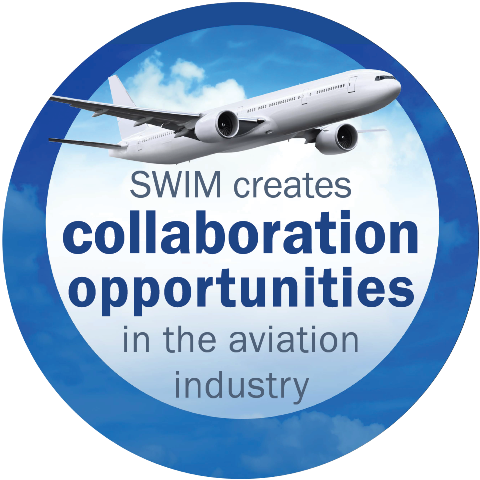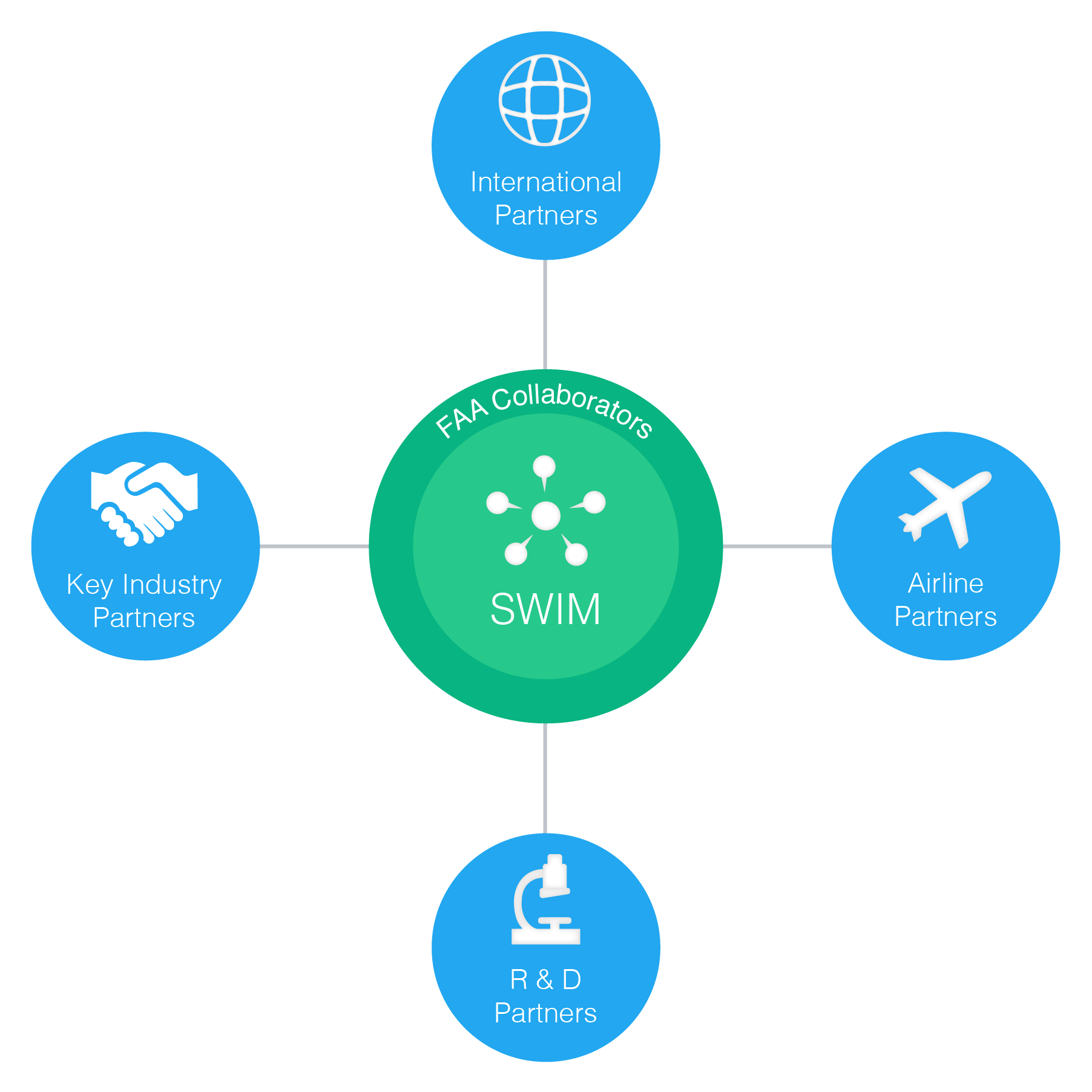SWIM Partners
SWIM Promotes Collaboration and Information Sharing
 As the System Wide Information Management (SWIM) Program strategically progresses towards an end goal of promoting information-sharing in the National Airspace System (NAS), it is increasingly important that the aviation community join with the SWIM Program as partners in shaping future needs. Partnerships with industry and other government agencies will enable the SWIM Program to provide the IT infrastructure necessary for NAS systems to share information, increase interoperability, and encourage reusability of information and services.
As the System Wide Information Management (SWIM) Program strategically progresses towards an end goal of promoting information-sharing in the National Airspace System (NAS), it is increasingly important that the aviation community join with the SWIM Program as partners in shaping future needs. Partnerships with industry and other government agencies will enable the SWIM Program to provide the IT infrastructure necessary for NAS systems to share information, increase interoperability, and encourage reusability of information and services.
Internally, the FAA's SWIM Program Office leads and manages the development and implementation of SWIM by working with key FAA collaborators to include the FAA William J. Hughes Technical Center (WJHTC) and FAA NAS Offices.
Key Partnerships

Key Industry Partners
Aviation Industry and Trade and Representation Groups represent the aviation community, including government organizations, airlines, airspace users, airport associations, labor unions, and aviation service and equipment suppliers. Through these associations, the SWIM Program is able to not only gain understanding of other aviation industry initiatives but also identify potential subscribers of SWIM-compliant data within industry.Key Prototype and Development Partners
The John A. Volpe National Transportation Systems Center and Massachusetts Instituteof Technology's (MIT) Lincoln Laboratories provide aviation expertise and coordination with the SWIM Program. The Volpe team was tasked with developing a SWIM-compliant Integrated Terminal Weather Service (ITWS) Prototype, while MIT Lincoln Labs is developing the SWIM-compliant Corridor Integrated Weather Service (CIWS) Prototype. SWIM's Flight Data Publication Service (FDPS) is also being developed at Volpe.
Key International Partners
The International Civil Aviation Organization (ICAO) is a specialized agency of the United Nations. ICAO codifies the principles and techniques of international air navigation and fosters the planning and development of international air transport to ensure safe and orderly growth. Implementation of the concepts behind SWIM have been a major topic of discussion at ICAO meetings and the SWIM Program has been providing information to the ICAO and its subgroups on the topic since early 2012.
Europe
Single European Sky Air Traffic Management (ATM) Research Joint Undertaking (SESAR JU) is a public-private partnership that includes European Organization for the Safety of Air Navigation (EUROCONTROL), the European Commission, other states, and European industry service providers and airport organizations. Information about the SESAR JU SWIM activities that align with the FAA SWIM Program can be found at the following website: https://www.sesarju.eu/projects/swim-ti.
The FAA and SESAR JU established a Memorandum of Cooperation (MOC) for civil aviation Research and Development (R&D). The primary purpose of the MOC was to create a legal mechanism for NextGen/SESAR collaboration. Included in the MOC is the Coordination Plan (CP) 2.1, which addresses SWIM interoperability and was approved in April 2012.
Asia/Pacific
Japan Civil Aviation Bureau (JCAB) is the Air Navigation Service Provider (ANSP) in Japan. The FAA and JCAB established the Future Air Transportation System Working Group (FATS WG) to harmonize future US and Japanese air traffic management systems. FATS WG meets twice a year to discuss SWIM and related topics, such as data exchange models. JCAB's Collaborative Actions for Renovation of Air Traffic Systems (CARATS) is analogous to the FAA's NextGen.
In addition, the SWIM Program has held several workshops and demonstrations with its colleagues from AirServices Australia (ASA), the Australian ANSP.
Airline Partners
Airline partners are critical to the success of the SWIM Program. Our valued airline partners enable SWIM to gain an understanding of the needs of the aviation industry, enabling the Federal Aviation Administration to provided world-class capabilities to support needed information management requirements.
